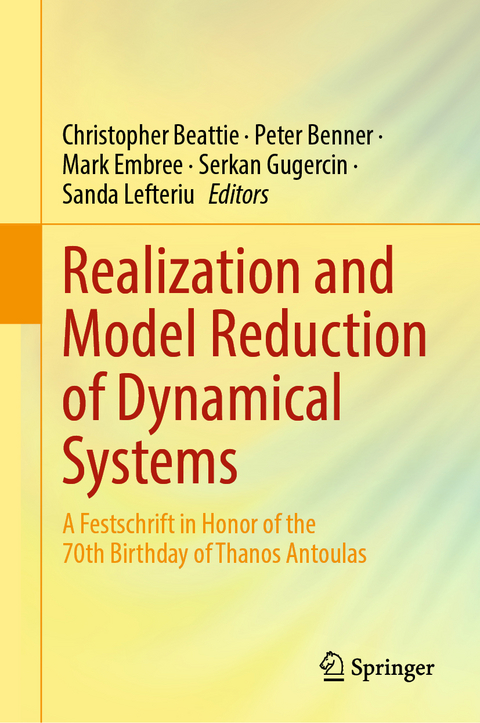
Realization and Model Reduction of Dynamical Systems
Springer International Publishing (Verlag)
978-3-030-95156-6 (ISBN)
This book celebrates Professor Thanos Antoulas's 70th birthday, marking his fundamental contributions to systems and control theory, especially model reduction and, more recently, data-driven modeling and system identification. Model reduction is a prominent research topic with wide ranging scientific and engineering applications.
lt;p>Christopher Beattie is Professor of Mathematics at Virginia Polytechnic Institute and State University. His areas of specialization are model reduction, computational linear algebra, spectral/eigenvalue estimation, numerical analysis, and scientific computing.
Peter Benner is Director and Scientific Member of the Max Planck Institute for Dynamics of Complex Technical Systems in Magdeburg, a Professor for Mathematics in Industry and Technology at TU Chemnitz, and Honorary Professor at the Department of Mathematics, Otto-von-Guericke University, Magdeburg. His research areas include model reduction, systems and control theory, numerical linear and multilinear algebra, PDE-constrained optimization, and uncertainty quantification.
Mark Embree is Professor of Mathematics at Virginia Polytechnic Institute and State University. With Nick Trefethen, he is co-author of Spectra and Pseudospectra: The Behavior of Nonnormal Matrices and Operators. His research interests include computational linear algebra and spectral perturbation theory.
Part I: Linear Dynamical Systems: B. Joseph, The rational interpolation problem: Grassmannian and Loewner-matrix approaches.- B. Jean-Paul, The conditioning of a linear barycentric rational interpolant.- D. Zlatko, Learning low-dimensional dynamical-system models from noisy frequency-response data with Loewner rational interpolation.- E. Mark, Pseudospectra of Loewner Matrix Pencils.- R. Paolo, A Loewner matrix approach to the identification of linear time-varying systems.- V. D. Paul, Linear System Matrices of Rational Transfer Functions.- Part II: Nonlinear Dynamical Systems: C. Xingang, Interpolation-based Model Order Reduction for Quadratic-Bilinear Systems and H2 Optimal Approximation.- C. Sridhar, An Adaptive Sampling Approach for the reduced basis method.- K. Boris, Balanced Truncation Model Reduction for Lifted Nonlinear Systems.- L. Sanda, Modeling the buck converter from measurements of its Harmonic Transfer Function.- P. Mihaly, Model reduction and realization theory oflinear switched systems.- Part III: Structured Dynamical Systems: F. F. Damasceno, Developments in the Computation of Reduced Order Models with the Use of Dominant Spectral Zeros.- M. Volker, Structure-preserving Interpolatory Model Reduction for Port-Hamiltonian Differential-Algebraic Systems.- P. D. Igor, Data-Driven Identification of Rayleigh-Damped Second-Order Systems.- S. Tatjana, Balanced truncation model reduction for 3D linear magneto-quasistatic field problems.- Van der S. Arjan, Structure-preserving model reduction of physical network systems.- Part IV: Model Reduction for Control: B. Tobias, H2-gap model reduction for stabilizable and detactable systems.- H. Matthias, Reduced Order Model Hessian Approximations in Newton Methods for Optimal Control.- P.-V. Charles, Interpolation-based irrational model control design and stabilty analysis.- Part V: Applications: D. Clifford, Oscillations in Biology: G. Eduardo, Model-Order Reduction for Coupled Flow andLinear Thermal-Poroplasticity with Applications to Unconventional Reservoirs.- I. Roxana, Challenges in model reduction for real-time simulation of traction chain systems.- N. Masaaki, Sparse Representation for Sampled-data Hinf Filter.- S. Eduardo, Analysis of a reduced model of epithelial-mesenchymal fate determination in cancer metastasis as a singularly-perturbed monotone system.
| Erscheinungsdatum | 13.06.2022 |
|---|---|
| Zusatzinfo | XIX, 460 p. 115 illus., 102 illus. in color. |
| Verlagsort | Cham |
| Sprache | englisch |
| Maße | 155 x 235 mm |
| Gewicht | 903 g |
| Themenwelt | Mathematik / Informatik ► Informatik ► Theorie / Studium |
| Mathematik / Informatik ► Mathematik ► Analysis | |
| Schlagworte | Approximation Theory • Data-driven modeling • Model Reduction • System Identification • Systems theory and control |
| ISBN-10 | 3-030-95156-1 / 3030951561 |
| ISBN-13 | 978-3-030-95156-6 / 9783030951566 |
| Zustand | Neuware |
| Haben Sie eine Frage zum Produkt? |
aus dem Bereich


